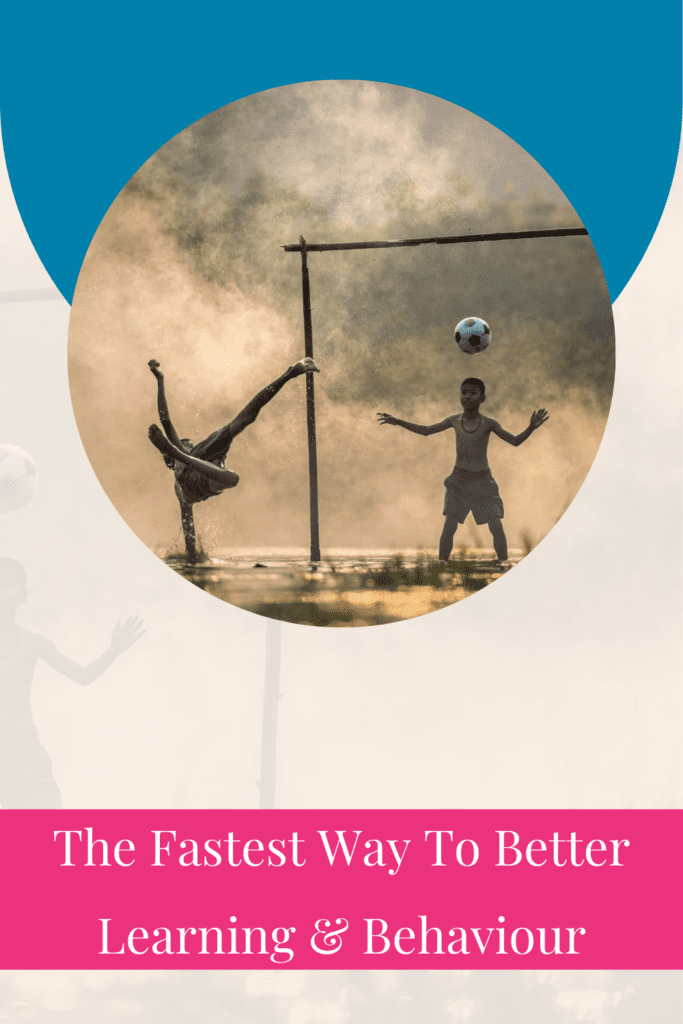Every single person I have talked to who specializes in addressing the root cause of learning and behaviour disorders among children will tell you the same thing. After nutrition, the single biggest factor that creates major gains is movement.
I have written plenty about the importance of movement to develop the brain, particularly in infancy. When these milestones are skipped or interrupted then impairments can occur. We have all heard about how amazing exercise is for the body.
We’ve had it drilled into our heads since childhood that it improves circulation and therefore oxygenation. Circulation to the body means better circulation to the brain. This also means that nutrients are more easily delivered to the brain.
Wonderful!
But really…like we didn’t know that already.
You want me to tell you something you don’t know?
The Only Difference Between a Star Student & a Struggling Student
The difference between a child who struggles in school with learning and behaviour and the child who is the ‘star student’ is the number of neurons and connections in their brain.
… and if your child is struggling you can help them change their brain. I hate to sound demeaning but you can literally help your child grow a different brain.
Besides nutrition – exercise is the next best thing to do that!
Here’s why…
Exercise does to brains what it does to muscles and hearts and lungs.
And children are not getting enough activity these days.
The concerns of inactivity among young children all the way to the teenage years is of grave concern. This matters not only because it impacts obesity and the health of the heart and lungs – but the brain as well.
It’s unfortunate that we do not see how much exercise changes the brain the way we do with the obvious changes of increased muscle mass, better respiration and weight loss. Just as exercise strengthens the heart, lungs and even bones, it has the same effect on the brain.
Exercise is Miracle Grow for Your Child’s Brain
Think of it like fertilizer.
When your child exercises, it feeds the brain with neurotrophins. If you’re wondering what the heck those are, think of these as the super food powders you mix into smoothies.
These high nutrient chemical packages increase the number of connections between neurons.
That is what makes your child smart! And less moody.
In 1999, researchers learned more than they expected. They found that exercise actually creates the growth of new neurons which ultimately resulted in better mood, cognitive abilities as well as memory.
Movement Builds Brains
If you’re old enough, you remember when science said that each person had a certain amount of brain cells and once they died, they didn’t come back.
So wrong.
Daily movement is where it starts. Children who exercise on a daily basis have increased cortical mass and more white matter in their brain which is responsible for attention, memory and retention.
What all of this means for your child is that exercise is important at any age.
If You Don’t Move It, You Lose It!
Brain integration therapy is a game-changer like nothing else when it comes to actually correcting retained reflexes, which are one of the core factors in learning and behaviour challenges. Yet movement in general helps to build brains.
After my clients complete my program, I always remind them that the movement has to continue. It’s not that all the results will disappear, but I see far too many clients make gains with movement therapy and then think the ‘job is done’.
Just as nourishing your brain with good food is a lifelong endeavour so is exercising.
Muscles & Brains Grow Together
Exercise builds muscle and exercise also builds brains. It literally makes them bigger. Exercise directly affects the hippocampus—it is double the size in children who exercise. A strong hippocampus results in a more rapid growth of new neurons (brain cells) as well as more molecules that play a role in brain plasticity.
And as for muscle building – that affects the brain as well. Exercise and increased muscle mass stimulate the production of BDNF. BDNF is necessary for the growth of brain cells in an area of the brain that is responsible for memory and also encourages the brain cells to expand, connect and communicate with other brain cells.
Tapping Into Your Child’s ‘Smart’ Genes
Researchers were even more shocked when in 2001 they stumbled across the incredible finding that exercise enhanced gene expression in areas that impacted brain plasticity.
…So if you have been buying into that myth that intelligence is genetic or that ridiculous stereotype that Asians are naturally smart – it’s BS.
Movement can change your genes. The positive gene expression from exercise improved the delivery of signals in the brain, the structure of the synapses and produced new neurons. It also increased activity of neurons and the connections between them.
Making Your Kid Smarter … & Better Behaved
It’s not just learning and reading ability that exercise improves. Studies on ADHD children found improved focus from regular exercise. A study from the University of Illinois found that children who were in shape performed better on various cognitive tests. The MRI even found they had a much larger basal ganglia.
The basal ganglia is what helps to keeps your child happy and calm. It is responsible for focus, improved thought processes, sensory regulation and impulse control. The bottom line is exercise assists in the brain’s ability to better integrate information.
Movement Therapy
While you should steer clear of any professional who promises you a miracle—many Educational Therapists, neurologists and other specialists trained in brain development and function will tell you that movement therapy is the one of the most effective and reliable forms of therapy for improving cognition and brain development.
It can reap huge benefits in children with neuro-developmental problems or adults who have suffered a stroke. This is why movement therapy is so widely practiced by professionals who specialise in improving brain development whether they work with children or aging adults.
How Movement Therapy Works
The reason movement therapy is so effective is that it activates the whole-brain through various whole-body exercises. It improves co-ordination, fine motor skills as well as proprioception. The visual and vestibular systems are activated.
Exercise helps your child’s brain to operate as a ‘whole-brain’ since it helps to unite the the brain’s left and right hemispheres, the top and bottom as well as the front and back regions. When these areas of the brain are not working optimally or together then you will see a variety of problems related to cognition, language, speech, reading, memory, reasoning, impulse control, fine motor skills.
To learn more about an approach that combines nutritional therapy with cognitive exercises that re-organize the brain and strengthens weak connections check out my programs Reading Rockstar Bootcamp and The Full Potential Clinic.
Set up a free 20-minute discovery session to learn more about how you can help your child improve their reading comprehension so they can become a fluent reader and a more confident kid.
Sources:
http://ivrylab.berkeley.edu/uploads/4/1/1/5/41152143/ivry_intl-rev_neurobio_1997.pdf
https://www.ncbi.nlm.nih.gov/pubmed/9072973
https://www.ncbi.nlm.nih.gov/pmc/articles/PMC5438138/
https://www.ncbi.nlm.nih.gov/pubmed/23965122
https://www.ncbi.nlm.nih.gov/pubmed/9753595
http://www.davidpublisher.org/Public/uploads/Contribute/56a9795c3eeae.pdf
https://www.ncbi.nlm.nih.gov/pubmed/9391022
https://www.ncbi.nlm.nih.gov/pmc/articles/PMC4525418/
http://www.ascd.org/publications/books/104013/chapters/Movement-and-Learning.aspx
https://www.ncbi.nlm.nih.gov/pmc/articles/PMC3845870/
https://www.mdpi.com/journal/children/special_issues/Dyslexia
https://www.intechopen.com/books/recent-advances-in-autism-spectrum-disorders-volume-i/co-occurrence-of-developmental-disorders-children-who-share-symptoms-of-autism-dyslexia-and-attentio
http://www.elfpreschool.com.sg/uploads/3/1/2/1/31211637/movement_&_learning.pdf


